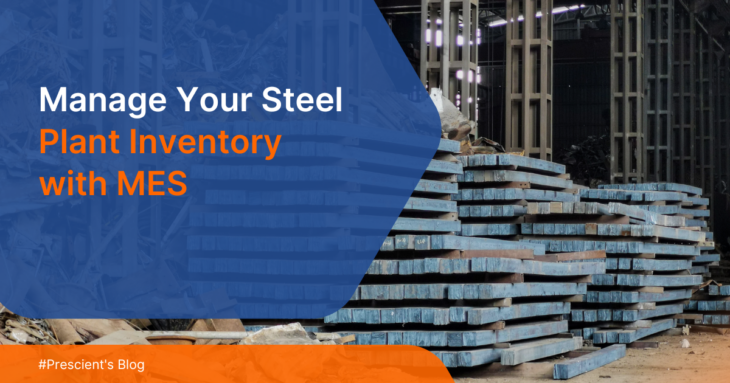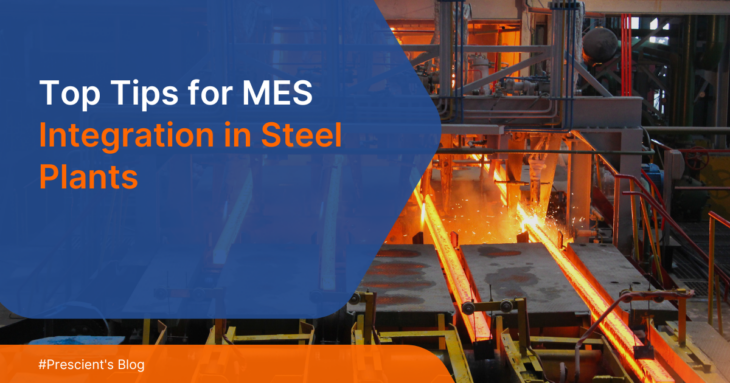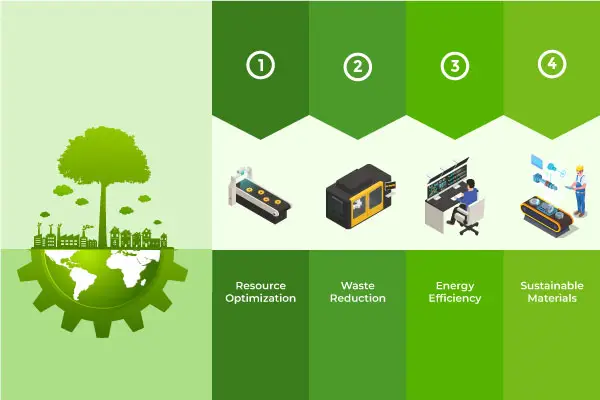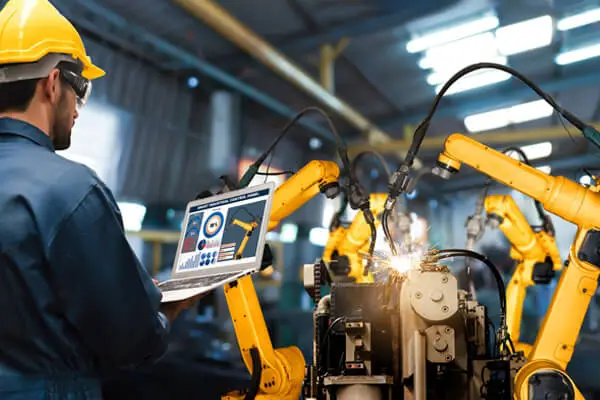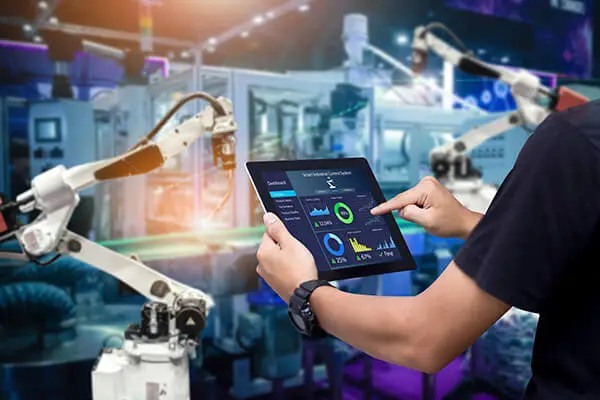How MES Improves Inventory Management in Steel Plants
The production of steel requires raw materials such as iron ore, coke, chemicals, scrap steel, fuels, and many other things that are made into the final product. All of these materials, including unfinished items, moving from one stage to the other, makeup inventory. Given the fact that inventory comprises raw materials, WIP, and finished products, the management of the inventory process is quite challenging. The key consequences of ineffective inventory management are elevated product costs, squandered resources, and time consumption. Having an option of tracking inventory in the production cycles through the Manufacturing Execution System (MES) can provide unique benefits to inventory management. In this blog, we focus on the MES inventory management in steel plants, as well as the advantages it has. How Inventory Management Works in a Steel Plant In a steel factory, inventory flows throughout the plant as the products are being made. Inventory can be classified into three main categories: Handling inventory in a steel plant involves moving materials from one place to another and storing them in buffer zones for each process. It should be noted that it moving and storing inventory throughout the plant involves costs and takes up space. Transporting raw materials and WIP items requires heavy-duty equipment, and maintaining large storage facilities also adds to expenses. If inventory builds up because of disruptions in the plant, it can lead to further disruption of the flow. For instance, too much WIP inventory can clog up production lines, create bottlenecks, and slow down the entire operation. This not only causes delays but also leads to increased operational costs. On the other hand, inadequate inventory can result in stockouts and halt production altogether. It’s a delicate balance to maintain enough inventory to keep things running without overloading the system. Efficient inventory management from the top down is key to minimizing delays and additional costs. Traditionally, it is a major task to keep a close watch on inventory levels and requires the cooperation of all departments to keep production going smoothly. How MES Improves Inventory Management MES inventory management in steel industry brings with it a suite of capabilities from real-time observation to ERP integration that can optimize the inventory management process. Here is now: 1. MES Integrates With ERP Systems MES is designed to integrate with Enterprise Resource Planning (ERP) systems to open up benefits that extend beyond what the individual systems can give. The integration links the production floor with business processes so it can help streamline inventory management and align production in accordance with all the other factors. Data analytics that comes from ERP systems become more powerful and provide insights into manufacturing, logistics, and supply chain efficiency. The biggest benefit is that the integration ensures that all departments, from procurement to production and sales, all work off the same data. 2. Real-Time Inventory Tracking MES inventory management in steel plants provides real-time tracking by using integrated sensors in the form of IIoT data collection across the production line. These sensors monitor inventory movement throughout the factory. They keep track of data from raw materials entering the plant to WIP material and the finished goods leaving for distribution. The system is highly beneficial for plans that use the ABC analysis for stock control. MES can maintain a vigilant eye on the category A items and ensure all are accounted for and wastage is reduced. Data is updated continuously in the system, allowing plant managers to see inventory status at a glance. This real-time tracking also helps prevent errors like overstocking or shortages by providing a quick view of inventory levels. Real-time inventory tracking is also crucial for plants utilizing the Just-In-Time of inventory management. MES tracking inventory at each station can automatically issue Kanban cards to bring in more material as the inventory gets depleted. Going further, by using the data available on inventory movement, operators can make decisions regarding production, halt to tackle challenges or divert workflow to avoid bottlenecks. 3. Automated Reordering and Stock Optimization When MES systems work together with ERP systems, they bring a higher level of smart decision-making to inventory management. The integration can be set to automate the reordering of raw materials based on real-time data and market trends. For instance, the steel market has been volatile for the last decade because of policy changes, supply chain constraints, and geopolitics. McKinsey even recommends that steel producers need to double down on technological agility to handle the volatility of the markets. If a spike in steel demand is expected, the system can be used to readjust order levels to keep up. With this capability, production can keep running smoothly without interruptions. 4. Reducing Waste and Improving Cost Efficiency MES inventory management in steel plants helps reduce waste and improve cost efficiency by tracking excess inventory and spotting waste reduction opportunities. It analyzes inventory levels and production data to reveal where surplus stock is piling up or where processes are inefficient. For example, if MES identifies an overstock of certain scrap-grade steel, it can prompt adjustments in raw materials to avoid unnecessary storage costs. The instant data-backed approach means that less money is wasted on unused inventory and storage. Basically, MES optimizes inventory management, which helps steel plants cut waste and manage costs more effectively. To Wrap It Up Efficient inventory management is crucial for optimizing operations in steel plants. MES systems provide highly useful tools and ERP integrations for complete visibility and precise control over inventory. As steel plants navigate the tough times of modern production, incorporating MES inventory management in steel production is the way forward to staying competitive. If you’ve been struggling with inventory management, then FactoryCONNECT is just the MES solution you need. To learn where you are losing time, money, and resources, get in touch with our team and ask for a demo today!
Read MoreHow MES Enhances Production Planning in Steel Plants
Production planning in steel plants is often considered a tough balancing act. Production planners need to align resources with market demands while hitting the plant’s production targets. It’s also a constant juggling of decisions to keep things running smoothly, as production units can sometimes run into delays and material rejection. That’s where a Manufacturing Execution System (MES) comes in to improve the functioning of steel plants. By providing real-time data and overall visibility over the operations, MES helps streamline the production planning process. In this MES production planning steel blog, we’ll explore how MES can make production planning easier and more efficient. What Production Planning Is and What It Entails Production planning is a strategic process necessary for the smooth operation of steel plants. It involves the organization and coordination of resources to meet production targets while aligning the whole thing with market demands. Basically, production planning ensures that the correct quantities of steel are produced with the quality expected for the batch or as requested by the client. One of the most important goals of production planning is using available resources efficiently to save costs and eliminate waste. Production planning is also a dynamic process that adjusts to changes in production conditions and market requirements. A well-executed production plan balances all the factors involved to avoid over-planning or under-planning, both of which can negatively impact the plant’s performance and costs. The various parts of production planning involve: How MES Enhances Production Planning in Steel Plants As is evident from the nuances of production planning, it’s a process that has a lot of scope for improvement with digitization. An MES that is properly implemented can offer plenty of advantages to the steel plant. Here are 6 areas where MES production planning steel advantages are evident. 1. Real-Time Data Collection Across the Plant In steel plants, having instant data on all the areas and equipment can go a long way in keeping production on track. MES systems make this easy by providing real-time insights straight from the production floor. Plant operators can know immediately if a furnace’s temperature drops below the threshold or if there’s a blockage in material flow, which can disrupt the whole process. This immediate feedback allows planners to tweak their production plan right away and avoid delays and wasted work. 2. Enhanced Scheduling and Resource Allocation Scheduling and resource allocation are key to keeping a steel plant running on time for deliveries. MES production planning steel systems manage production by creating more accurate schedules based on real-time data on the floor. For instance, if the MES detects that the annealing section is running slower than usual because of a fault, it adjusts the schedule to prevent bottlenecks. The system also helps allocate resources like labor and materials in the right place to gain speed or keep up with the flow. MES aligns production schedules with current conditions and available resources to meet targets without overloading the equipment. 3. Predictive Maintenance and Downtime Reduction Predictive maintenance has been a breakthrough for steel plants, which have traditionally been affected by unexpected downtimes and sudden failures. The systems continuously monitor equipment performance using IIoT devices and analyze the data. By real-time and historical analysis of performance data, MES can predict when a machine might fail or need maintenance. For instance, if a visual sensor detects the unusual orientation of rebars coming out of the rolling mill, the system can alert operators before a major breakdown occurs. 4. Better Inventory Management to Reduce Costs Managing inventory in a steel plant is all about striking a fine balance. The plant needs enough raw materials and in-process goods to keep production flowing. However, having too much material in the inventory can lead the costs to skyrocket. MES systems help strike that balance by providing real time visibility into inventory levels and comparing it with running conditions and expected throughput. If supplies are running low, the system alerts the planners to reorder material before it impacts production. Conversely, it helps avoid overstocking by aligning inventory with actual production needs. By keeping inventory levels just right, MES reduces waste, cuts costs, and ensures that the production plan stays on track without unnecessary delays or excess. 5. Improved Quality Control Quality control is a critical factor in steel production as the material properties of the output depend on it. While manual quality control has challenges, MES systems take it to the next level by maintaining a strict tolerance. MES systems continuously monitor steel production so that quality standards are met at every stage. Closing Thoughts Integrating MES into steel production planning enhances how plants operate from a fundamental level. From real-time data collection to strict quality control, MES production planning steel systems make the production planning process a whole lot simpler. Digitization helps planners make better decisions and optimize resources so the plants can meet production targets on budget and stay competitive in the market. FactoryCONNECT is a cutting-edge MES solution for manufacturing units. By seamlessly integrating across your systems on the production floor, it provides real-time data, better scheduling, and improved quality control. Take control of your operations with complete visibility into the plant with FactoryCONNECT. Contact us today to learn how we can transform your steel plant!
Read MoreBest Practices for Successful MES Integration in the Steel Industry
Steel production is one of the oldest industries in the world with well-established procedures and methodologies that have sustained for decades. In the modern day, the old ways are insufficient to deal with factors such as market volatility, costs, competition, etc. Implementing an MES system optimizes the functioning of steel plants by streamlining the processes and keeping up with the market. In this article, we take a closer look at the MES integration best practices steel industry. From setting clear goals to involving the right people and choosing the right solution, we’ll cover what it takes to make your MES implementation a success. Top Best Practices for Successful MES Integration Let’s check out the best practices for successful integration in detail: 1. Identify the Need and Scope for MES The first step in MES integration is understanding why you need it and what you want it to achieve. Start by asking what specific problems you are trying to solve. It can be real-time monitoring of the temperature of the cast billets, tight control of the composition of the steel, or gaining better visibility over the entire production. Clearly defining your goals will help you have a good picture. Next, consider the scope of the solution’s implementation. MES systems are often broad and cover everything from inventory management to real-time monitoring and client communication. Determine which areas of your plant will benefit the most to pick the right solution. 2. Discuss MES Features and Scope With All Stakeholders Once you’ve identified the need for MES, it’s essential to involve all stakeholders, from the level of upper management to the operators, IT teams, and even the suppliers, in discussions about its features and scope. Explain how the MES will impact their work and highlight the benefits. For example, automating reporting can reduce manual tasks for operators in the form of data gathering and report writing. Employees also won’t have to be around machinery all the time with data being available on their mobile devices. Transparency is key, especially for older workers who may fear technology changes. Address their concerns openly and show how MES will enhance, not replace, their roles. 3. Develop User Requirements for the System Part of MES integration best practices steel industry starts with understanding the specific needs of those who will use it daily. Not all features offered by a solution are necessarily useful in the plant. Therefore, developing user requirements, which involves gathering input from everyone involved, from operators on the floor to IT specialists, is necessary. What do they need the system to do? Floor operators might require easy access to real-time data on production metrics, while IT teams would prioritize seamless integration with standardized data with existing systems. By involving users in this process, you ensure the MES is tailored to the plant’s unique needs. 4. Prepare Gap Analysis With Existing System and Interfaces A major part of implementing MES is conducting a gap analysis to identify where your current systems fall short. In a steel factory, for example, you might find gaps in real-time data collection where older machines don’t provide timely information on production metrics. Another gap could be a lack of integration between the SCADA system and business software. Fixing these involves prioritizing solutions like adding sensors to older equipment or using middleware to bridge different systems. Gap analysis helps you focus on areas that need improvement so a smoother MES integration and overall efficiency can be achieved. 5. Choose the Right MES Solution and Vendor Start by evaluating your specific needs. Most MES system features out there have functionalities you require, like real-time monitoring, data analysis, or quality control. But what you need to consider is how well the system integrates with your existing equipment and software. Can the vendor handle the challenges unique to your plant and production methods, or can they adapt their system as needed? Equally important is choosing a vendor with a strong track record in the steel industry. Look for a partner who understands your challenges and offers ongoing support. Don’t hesitate to ask for case studies or references to ensure their solution aligns with your goals. 6. Implement MES System incrementally It’s ideal to take an incremental approach. Start with a pilot phase in a specific area of your plant, like with temperature sensors at the rolling mill or casting line or the energy meters across machines. This allows you to test the system, address any issues, and make adjustments before scaling up. By rolling out the MES gradually, you can better manage disruptions, gather feedback from users, and ensure the system meets your expectations. Each successful step builds confidence among your team and helps refine the process, making the full-scale implementation smoother. 7. Focus on Training and Support Even the best MES system can’t deliver results if your team isn’t fully trained to use it effectively. Build comprehensive training programs in a phased manner that follows the gradual implementation. The training should cover not just the basics but also how the system can be optimized for daily operations. 8. Measure and Optimize Performance Continuously measuring the MES’s performance is key to ensuring you’re getting the most out of your investment. Start by tracking key metrics like energy consumption, downtime, quality control, and time to customer. For instance, if your MES shows a drop in the speed of billets moving from the annealing process to finishing, investigate the cause and make necessary adjustments. Then move on to the next process that has become a bottleneck. Closing Thoughts Successful MES integration in the steel industry is a process that requires careful planning, collaboration, and steady but continuous improvement. By following MES integration best practices steel, you can unlock the full potential of your operations. If you’re looking to get started with an MES system at your plant, then look no further than FactoryCONNECT. The MES system offers seamless integration with all your existing hardware benefits that can transform your plant today. Contact us to learn
Read MoreGreen Manufacturing with Digital Factories: A Sustainable Approach
Table of content The Evolution of Manufacturing The Digital Revolution in Manufacturing The Synergy of Green Manufacturing and Digital Factories Challenges and Adoption Hurdles Conclusion Industries around the world are reviewing their procedures in an era characterized by rising environmental concerns and a greater understanding of the need for sustainability. Production is one area that is undergoing a huge transition, as the fusion of technology and sustainability is paving the way for green production and digital factories. These novel methods are increasing productivity and profitability while also minimizing the impact of manufacturing on the environment. We will discuss the idea of green manufacturing using digital factories in this post, as well as how it can help create a more sustainable future. The Evolution of Manufacturing Manufacturing has come a long way since the Industrial Revolution. In the early days, factories were notorious for the adverse environmental impacts their units had, with unchecked pollution and waste. However, over time, regulations, public awareness, and advancements in technology have forced manufacturers to rethink their practices. The concept of green manufacturing emerged as a response to these challenges. It entails minimizing the environmental impact of manufacturing processes by reducing resource consumption, waste generation, and emissions. It is about finding ways to produce goods more efficiently and sustainably. The Digital Revolution in Manufacturing The digital revolution has profoundly impacted almost every aspect of our lives, and manufacturing is no exception. Digital technologies such as the Internet of Things (IoT), Artificial Intelligence (AI), big data analytics, and automation are transforming the way products are made. Digital factories are at the forefront of this transformation. These are manufacturing facilities where digital technologies are integrated into every aspect of the production process. The key elements of digital factories include: The Synergy of Green Manufacturing and Digital Factories Sustainability is a shared objective of digital factories and green manufacturing. When these two ideas are joined, a potent synergy results that might completely alter the manufacturing sector. Challenges and Adoption Hurdles While the concept of green manufacturing with digital factories is promising, it comes with its share of challenges and adoption hurdles. These obstacles should be acknowledged and addressed to ensure a smoother transition to sustainable manufacturing practices. Despite these challenges, the future of green manufacturing with digital factories appears promising. As technology continues to advance, costs are likely to decrease, making these innovations more accessible to a broader range of manufacturers. Government incentives and regulations focused on sustainability are also expected to drive adoption. It is essential for manufacturers to acknowledge and address these challenges, working collaboratively with stakeholders to create a more sustainable and environmentally responsible future for the manufacturing industry. Green manufacturing with digital factories is not just a concept; it is a path to a more sustainable and prosperous future for all. Conclusion Green manufacturing with digital factories represents a sustainable approach that is reshaping the manufacturing landscape. By combining the principles of resource optimization, waste reduction, energy efficiency, sustainable materials, and supply chain sustainability, these factories are not only reducing their environmental impact but also improving their efficiency and profitability. As we move forward, it is essential for manufacturers to embrace this transformation and work collaboratively with stakeholders to create a more sustainable and environmentally responsible future for the manufacturing industry. Green manufacturing with digital factories is not just a concept; it is a path to a more sustainable and prosperous future for all.
Read MoreDigital Factory Best Practices: Optimizing Efficiency and Production
Table of content Understanding the Digital Factor Best Practices for a Digital Factor The Road to a Successful Digital Factory The traditional factory is experiencing a dramatic shift into what is frequently referred to as the “Digital Factory” in the fast-changing production scene. The adoption of cutting-edge technologies, data analytics, and automation in the production process are factors driving this transformation. A Digital Factory has one clear objective: to maximize productivity and efficiency while maintaining high product quality and adaptability. The most effective methods for achieving these goals within the framework of a digital factory have been discussed in this article. Understanding the Digital Factory Before delving into best practices, it is crucial to fully understand what a Digital Factory entails. At its core, a Digital Factory leverages digital technologies to connect and streamline every aspect of the manufacturing process. This includes automation, the Internet of Things (IoT), data analytics, artificial intelligence (AI), and more. Here are some key components of a Digital Factory: Best Practices for a Digital Factory Now that we have a grasp of what a Digital Factory encompasses, let us explore the best practices for optimizing efficiency and production in this context. 1. Data-Driven Decision-Making Data is the lifeblood of a Digital Factory. To make informed decisions, it is essential to gather, analyze, and interpret data effectively. Here’s how to do it: 2. Digital Twin Implementation Digital twins provide a virtual replica of your factory, allowing you to simulate and test changes before implementing them in the real world. Key steps include: 3. Integration of Automation Automation is a cornerstone of the Digital Factory concept. Here’s how to maximize its benefits: 4. Agile and Flexible Manufacturing A Digital Factory should be adaptable to changing market demands. Here’s how to achieve agility and flexibility: 5. Cybersecurity and Data Privacy With the increased connectivity in a Digital Factory, cybersecurity becomes paramount: 6. Employee Training and Empowerment A Digital Factory is only as effective as its operators and staff: 7. Sustainability and Energy Efficiency Incorporate sustainability practices into your Digital Factory: The Road to a Successful Digital Factory The journey to establishing a successful Digital Factory is not without challenges. It requires a significant investment in technology, talent, and a cultural shift towards embracing digital transformation. However, the benefits are substantial, including increased efficiency, higher product quality, and enhanced adaptability to market changes. To summarize, the best practices for optimizing efficiency and production in a Digital Factory are rooted in data-driven decision-making, digital twin implementation, automation, agility, cybersecurity, employee empowerment, and sustainability. By incorporating these practices into your manufacturing strategy, you can position your factory for success in the digital age and stay ahead of the competition. The future of manufacturing is digital, and the time to embrace it is now.
Read MoreEmerging Trends in Digital Factories: Shaping the Future of Manufacturing
Table of content Understanding Digital Factories Emerging Trends in Digital Factories Emerging Trends in Digital Factories Conclusion Digital transformation is fueling unheard-of developments in the industrial setup’s quickly changing landscape, resulting in the rise of digital factories. These cutting-edge manufacturing facilities are at the forefront of innovation, utilizing state-of-the-art technology to streamline procedures, boost productivity, and reimagine manufacturing processes. Several major trends are influencing the future of manufacturing as we move deeper into the twenty-first century, and digital factories are at the center of this shift. Understanding Digital Factories At its core, a digital factory is a manufacturing facility that leverages advanced digital technologies to optimize and streamline every facet of the production process. It represents a convergence of physical manufacturing with digital capabilities, resulting in a seamless integration of data, machines, and processes. Unlike conventional manufacturing, where physical operations often dominate, digital factories place data-driven decision-making and automation at the forefront. Central to the concept of a digital factory is the idea of interconnectedness. This interconnectedness spans machines, sensors, devices, and even personnel, creating a networked ecosystem that enables real-time data sharing and collaboration. The data generated by these interconnected systems provides insights that drive operational improvements, enhance product quality, and facilitate predictive maintenance. Emerging Trends in Digital Factories Now that we have a solid understanding of what digital factories entail, let’s delve into the emerging trends shaping their trajectory and influencing the future of manufacturing. ● Smart Manufacturing and Industry 4.0 The fourth industrial revolution is leading in an era of smart manufacturing that relies on interconnected systems and real-time data analysis. Digital factories leverage technologies like the Internet of Things (IoT) and Artificial Intelligence (AI) to create highly interconnected ecosystems. These ecosystems enable machines, sensors, and devices to communicate and collaborate autonomously, leading to seamless production processes and real-time decision-making. Integrating Industry 4.0 principles in digital factories enables predictive maintenance, where machines can identify and address potential issues before they result in downtime. This predictive approach reduces operational disruptions and optimizes maintenance schedules, thereby improving overall productivity and resource utilization. ● Robotics and Automation Automation has been a cornerstone of manufacturing for decades, but digital factories are taking it to new heights with the integration of advanced robotics. Collaborative robots, or cobots, are becoming increasingly common in these settings. These robots can work alongside human operators, enhancing efficiency and precision in tasks ranging from assembly to quality control. Machine learning algorithms are also employed to teach robots complex tasks, enabling them to adapt to changing environments and requirements. This increases flexibility and reduces the need for reprogramming when tasks change, making manufacturing processes more agile. ● Digital Twins Digital twins are virtual copies of physical products, processes, or systems. These twins are created in digital factories to simulate and analyze various aspects of the production process. By generating a digital representation of a product or a production line, manufacturers can run simulations and scenarios to optimize efficiency, test different variables, and identify potential bottlenecks. Digital twins enable data-driven decision-making by providing insights into how changes in one aspect of the process might impact the entire production line. This technology minimizes risks, accelerates development cycles, and enhances overall product quality. ● Additive Manufacturing and 3D Printing Additive manufacturing, commonly known as 3D printing, revolutionizes how products are designed and produced. Digital factories capitalize on this technology to create intricate and customized components with reduced material waste. This approach simplifies the production process and allows for on-demand manufacturing, reducing the need for large inventories. Moreover, additive manufacturing enables the production of complex geometries that were earlier challenging or impossible to create using traditional manufacturing methods. This level of design freedom opens up new possibilities for innovation across industries. ● Data-Driven Decision Making The influx of data generated by interconnected systems in digital factories is a goldmine for informed decision-making. With advanced data analytics, manufacturers can gain insights into production trends, performance metrics, and customer preferences. This information helps optimize processes, identify areas for improvement, and tailor products to meet market demands more effectively. Machine learning and AI algorithms can detect patterns in large datasets that human analysts might miss. This predictive analysis can guide manufacturers in adapting to changing market conditions swiftly and proactively. ● Cybersecurity Challenges The interconnected nature of digital factories presents both opportunities and challenges. The primary challenge often encountered is cybersecurity. With the increase in interconnected devices and data exchange, the potential attack surface for malicious actors also expands. Securing sensitive production data, proprietary designs, and critical infrastructure becomes paramount. Manufacturers must implement robust cybersecurity measures to safeguard their digital factories against cyber threats. This includes encryption, multi-factor authentication, intrusion detection systems, and regular security audits. ● Sustainability and Green Manufacturing As the world grapples with environmental concerns, sustainability has become a central focus for industries, including manufacturing. Digital factories are contributing to sustainable practices through various means. One of the ways this is achieved is by optimizing processes to reduce waste and energy consumption. Data-driven insights enable manufacturers to identify inefficiencies and implement eco-friendly solutions. Additive manufacturing also plays a role in sustainability by minimizing material waste, and it has the potential to revolutionize supply chains with localized production. This helps reduce the carbon footprint in relation to the transportation and storage of goods. ● Global Supply Chain Transformation Digital factories are reshaping traditional global supply chains. By adopting localized manufacturing practices and leveraging technologies like additive manufacturing, companies can reduce their dependence on complex and lengthy supply chains. This shift allows for quicker response times to market demands, reduced lead times, and greater flexibility in addressing regional preferences. ● Skill Transformation and Workforce Development Integrating advanced technologies in digital factories necessitates a shift in workforce skills. As automation and AI become more prevalent, workers must acquire new skills to manage and maintain these technologies. Upskilling and reskilling programs are becoming essential to ensure that the workforce remains relevant and adaptable in the face of technological changes. ● Human-Machine Collaboration While automation and robotics are advancing, human workers remain integral to manufacturing processes. Digital
Read MoreOvercoming Challenges: Implementing a Successful Digital Factory Strategy
Table of content Legacy System IntegrationData Management and InteroperabilityWorkforce Transformation and Skills GapCybersecurity and Data PrivacyEnsuring Return on InvestmentChange Management and Organizational Alignment Conclusion The digital factory has become a potent force for operational excellence, efficiency, and innovation in today’s quickly changing manufacturing market. The prospects for manufacturers are enormous because of the integration of cutting-edge technologies, automation, and data-driven processes in digital factories. A successful digital industrial plan can be difficult to implement, though. This article examines the main obstacles businesses experience while adopting and implementing digital manufacturing methods and offers suggestions on how this goal can be accomplished. Manufacturers may fully utilize the capabilities of digital factories and promote sustainable growth in the digital era by comprehending and addressing these problems. Legacy System Integration Integrating old systems with new technology and processes is one of the key difficulties in putting a successful digital factory plan into practice. Existing systems in many manufacturing businesses, such as ERP, MES, and machine control systems, are not built to communicate easily with digital technology. Integration of legacy systems necessitates thorough planning, assessment, and perhaps a phased approach. It is essential to outline the shortcomings and loopholes in the current systems and assess how well they work with emerging digital technologies. To achieve a seamless transition and reduce operational disruptions, a defined plan for integration that addresses data transfer, system compatibility, and process redesign is important. Data Management and Interoperability Data management and interoperability present significant challenges in the implementation of a digital factory strategy. Digital factories generate vast amounts of data from various sources, including sensors, machines, and other connected devices. Managing and harnessing this data effectively is crucial for deriving meaningful insights and driving data-driven decision-making. Manufacturers must create strong data governance frameworks in order to address data management difficulties. For this, it is necessary to specify data standards, data ownership, data security procedures, and data integration tactics. Adopting industry standards, such as the Manufacturing Enterprise Solutions Association’s (MESA) models or the Industrial Internet Consortium’s Reference Architecture (IIoT RA), can help with data transmission and interoperability across various systems. Another crucial step is to put in place a strong data analytics infrastructure. This entails using cutting-edge analytics tools, cloud-based platforms, and machine learning algorithms to examine and extract useful insights from the enormous volume of data generated in the digital factory. In order to guarantee data reliability, precision, and consistency, manufacturers also need to invest in data quality assurance procedures. Workforce Transformation and Skills Gap Digital factories need knowledgeable and flexible staff who can use new technologies, analyze data, and work in cross-functional teams. But closing the skills gap and modernizing the workforce presents a substantial obstacle to implementing a digital industrial strategy. Manufacturers should prioritize worker development and upskilling projects to overcome this issue. This includes funding training initiatives emphasizing data analytics, automation, digital literacy, and group problem-solving. Manufacturers can empower their employees to adopt digital technology, adjust to new roles and responsibilities, and drive digital transformation by giving them the skills and knowledge they need. A culture of creativity and constant learning must also be promoted. Manufacturers ought to foster a culture that values experimentation, knowledge exchange, and cross-functional cooperation. A culture of innovation can be cultivated, and staff members can be assisted in adapting to the evolving digital landscape by adopting a growth mindset and offering continuing assistance and mentorship. Cybersecurity and Data Privacy Implementing a digital manufacturing plan is significantly hampered by cybersecurity and data privacy issues due to our growing interconnectedness and reliance on digital technologies. Cyber dangers like data breaches, ransomware attacks, and intellectual property theft might strike digital factories. Manufacturers must prioritize effective cybersecurity measures to reduce cybersecurity risks. Strong access controls, encryption techniques, network security, and intrusion detection systems should all be put in place. Regular security audits, vulnerability assessments, and employee awareness training are also crucial to maintain a proactive and alert security posture. Data security, adherence to laws like the General Data Protection Regulation (GDPR), and industry-specific standards are also essential. Manufacturers are required to provide clear data privacy rules, ensure the security of data transmission and storage, and get consent for data gathering. Data protection measures are interwoven into the fabric of the digital factory strategy when privacy-by-design concepts are used. Ensuring Return on Investment Investing in digital factory technologies and infrastructure requires substantial financial resources. Organizations must carefully evaluate and plan their investments to ensure a positive Return on Investment (ROI). Demonstrating the value and benefits of digital factories is crucial for securing executive support and funding. To maximize ROI, organizations should conduct a comprehensive cost-benefit analysis, considering factors such as increased productivity, reduced downtime, improved quality, and operational efficiencies. Developing a clear business case, setting measurable goals, and establishing Key Performance Indicators (KPIs) will help track progress and reflect the impact of digitalization on the bottom line. Change Management and Organizational Alignment Change management and organizational alignment are critical aspects of implementing a successful digital factory strategy. The adoption of digital technologies and new ways of working can disrupt established workflows and create resistance within an organization. Therefore, effective change management is crucial to ensure a smooth transition and employee buy-in. In order to align and transform an organization, leadership is essential. It is crucial to explain the goals and advantages of digital manufacturing to employees, answering any doubts or worries they may have. Organizations may establish a setting that welcomes change and promotes innovation by fostering a culture of openness, collaboration, and continual learning. Furthermore, involving employees in the decision-making process and soliciting their feedback can generate a sense of ownership and commitment to the digital factory strategy. Regular communication, training, and coaching sessions help employees understand the value of digitalization and how it aligns with the organization’s goals and objectives. Conclusion Implementing a successful digital factory strategy is a complex undertaking, but the rewards are significant. By addressing key challenges, manufacturers can unlock the full potential of digital factories. Embracing a holistic approach that encompasses
Read MoreSustainable Manufacturing: How Digital Factories Contribute to Environmental Conservation
Table of content Digital Factories: Pioneering Sustainable Manufacturing Practices Energy Efficiency and Resource OptimizationEmission Reduction and Environmental ImpactWaste Reduction and RecyclingLife Cycle Assessment and Sustainable Product DesignRemote Monitoring and Predictive Maintenance Conclusion The industrial sector is undergoing a fundamental change as it moves towards sustainable practices at a time when environmental sustainability has assumed great importance. A digital factory, which harnesses cutting-edge technologies and data-driven processes to pioneer a greener future, is at the forefront of this transition. The manufacturing landscape is changing as a result of digital factories’ continuous dedication to environmental preservation. These factories not only contribute to a more sustainable earth through energy efficiency, emission reduction, waste management, and sustainable product design but also promote operational excellence and cost savings. Join us on this journey, where we explore how digital factories are revolutionizing manufacturing while making substantial contributions to environmental preservation. Digital Factories: Pioneering Sustainable Manufacturing Practices Digital factories significantly advance environmental preservation by enabling the adoption of sustainable manufacturing techniques. These factories are transforming the way manufacturing processes affect the environment through various programs and technology. Energy Efficiency and Resource Optimization Digital industries prioritize resource efficiency and energy conservation since they have a substantial positive environmental impact. These factories use a combination of smart technology, sensors, and real-time data analytics to maximize energy efficiency, reduce waste, and diminish the environmental impact of manufacturing operations. Implementing automatic energy management, installing intelligent lighting systems, and closely watching equipment are some ways to increase energy efficiency. Digital factories optimize energy use to cut down on greenhouse gas emissions and overall energy use, making manufacturing more environmentally friendly. Additionally, digital factories use advanced analytics to maximize resource usage. Manufacturers are able to identify improvement opportunities and execute waste-reduction strategies by examining data on material utilization, production techniques, and supply chain operations. As part of this, inventory levels should be optimized, scrap and rework should be decreased, and circular economy concepts should be adopted, which put an emphasis on material reuse and recycling. Emission Reduction and Environmental Impact In order to reduce emissions and the negative environmental effects of manufacturing processes, digital factories are essential. These factories increase efficiency through data-driven optimization and process control, which lowers emissions and pollutants. Digital factories use real-time data analytics to efficiently monitor and control emissions from a variety of sources, including production machinery and fleets of vehicles. Manufacturers may considerably reduce air and water pollution by streamlining production processes, cutting down on idle time, and putting emission control systems in place. Additionally, digital factories aggressively support environmentally friendly transportation methods. Manufacturers can optimize logistics routes, shorten transportation distances, and combine shipments using the power of data analytics. As a result, fuel use is reduced, and carbon emissions are reduced. Digital technologies also allow for remote monitoring and preventative maintenance, which reduces the need for unnecessary travel and the resulting environmental effects. Waste Reduction and Recycling Digital factories prioritize waste reduction and recycling, contributing to a circular economy model. These factories identify opportunities to minimize waste generation and implement recycling initiatives through data analytics and process optimization. Digital factories can find inefficiencies and put waste reduction strategies in place by examining data on material usage, inventory control, and manufacturing processes. This entails streamlining production schedules, reducing overproduction, and putting lean manufacturing practices—which seek to do away with non-value-added activities—into practice. Furthermore, digital factories promote recycling and the reuse of materials. Manufacturers can identify recyclable materials through advanced sorting techniques and material tracking systems and ensure they are properly segregated and sent for recycling. This reduces the reliance on virgin resources, conserves energy, and minimizes waste sent to landfills. Life Cycle Assessment and Sustainable Product Design Digital factories facilitate lifecycle assessment and sustainable product design practices. By leveraging data analytics and simulation tools, manufacturers can assess the environmental impact of their products throughout their lifecycle and make informed decisions to reduce their footprint. Manufacturers can assess many design options, materials, and production processes to determine those with the lowest environmental effect through digital simulations and virtual prototyping. This makes it possible for them to create goods that are more sustainable, taking into account things like energy usage, resource utilization, recyclable materials, and end-of-life disposal. Digital factories also facilitate product traceability and transparency. By capturing and analyzing data at each stage of the product life cycle, manufacturers can provide customers with information on the product’s environmental impact, enabling more informed purchasing decisions and fostering a culture of sustainability. Remote Monitoring and Predictive Maintenance Digital factories enable remote monitoring and predictive maintenance practices, which contribute to environmental conservation by reducing energy waste and optimizing maintenance activities. Remote monitoring allows manufacturers to gather real-time data on equipment performance and energy consumption without the need for on-site personnel. By leveraging sensors and connectivity, digital factories can remotely monitor machines, systems, and energy usage, enabling proactive identification of inefficiencies or abnormalities. This early detection allows for prompt corrective actions, minimizing energy waste and reducing the environmental impact. Predictive maintenance, made possible by data analytics and machine learning algorithms, also aids in the optimization of maintenance procedures and the reduction of unscheduled downtime. Digital factories can forecast maintenance needs and plan maintenance actions at the most advantageous periods by assessing historical data, performance patterns, and equipment health indicators. Using this method, superfluous preventive maintenance can be avoided, and the possibility of unexpected equipment failures or breakdowns decreases. As a result, resources, energy, and materials are saved, making the manufacturing process more sustainable. Conclusion Digital factories are driving sustainable manufacturing practices and playing a pivotal role in environmental conservation. Through energy efficiency, emission reduction, waste management, and data-driven optimizations, these factories are transforming the manufacturing landscape. By prioritizing resource optimization, adopting circular economy principles, and promoting sustainable product design, digital factories contribute to a more sustainable and environmentally responsible approach to manufacturing. Remote monitoring, predictive maintenance, and data-driven sustainability improvements enhance their positive impact. By embracing digital technologies and sustainability principles, manufacturers can achieve their production goals while minimizing their ecological footprint.
Read MoreThe Importance of Cybersecurity in the Era of Digital Factories
Table of content Understanding the Cybersecurity Risks in Digital Factories Unauthorized Access and Data BreachesSabotage of Manufacturing ProcessesSupply Chain Vulnerabilities Implications of Cyberattacks on Manufacturing Operations Disruption of Production Processes and Financial ImpactJeopardizing Product Security and Quality Essential Cybersecurity Practices for Digital Factorie The Human Factor: Fostering a Culture of Cybersecurity Conclusion The industrial sector is quickly adopting the idea of a “digital factory” to boost operational effectiveness, reduce procedures, and spur innovation as digital transformation spreads across industries. Given the increased interconnectedness and reliance on technology, it is impossible to overestimate the significance of cybersecurity in digital manufacturing. Strong cybersecurity measures are vital as factories grow increasingly networked and data-driven, rendering them vulnerable to cyber assaults. This article examines the importance of cybersecurity in the age of digital manufacturing. We examine potential threats to digital factories, talk about how cyberattacks affect production processes, and highlight crucial cybersecurity tactics and techniques to protect these increasingly interconnected environments. Understanding the Cybersecurity Risks in Digital Factories Digital factories, driven by the Internet of Things (IoT), cloud computing, and automation, are highly interconnected ecosystems. While this interconnectivity enhances operational efficiency and enables real-time data analysis, it also exposes factories to various cybersecurity risks. Understanding these risks is crucial for implementing effective security measures. Unauthorized Access and Data Breaches Digital factories generate vast amounts of valuable data, including intellectual property, sensitive customer information, and operational data. Cybercriminals can exploit vulnerabilities in the network infrastructure, IoT devices, or weak access controls to gain unauthorized access and steal or manipulate this data. Sabotage of Manufacturing Processes Cyberattacks targeting digital factories can result in production downtime, equipment malfunctions, or tampering with critical systems, leading to severe financial losses, damage to brand reputation, and even safety hazards. Supply Chain Vulnerabilities Digital factories rely on an extensive network of suppliers, partners, and contractors, creating potential entry points for cyber threats. A breach in any part of the supply chain can expose the ecosystem to vulnerabilities and threats, compromising the security and integrity of the entire manufacturing process. Implications of Cyberattacks on Manufacturing Operations A successful cyberattack on a digital factory could have far-reaching effects and affect all aspects of manufacturing. Recognizing the effects of these attacks highlights how crucial strong cybersecurity measures are. Disruption of Production Processes and Financial Impact A cyberattack can disrupt production processes, causing downtime and delays. This can result in significant financial losses and missed delivery deadlines, affecting customer satisfaction and contractual obligations. The financial impact extends beyond immediate losses, as factories may also face legal liabilities and regulatory penalties. Jeopardizing Product Security and Quality A cyberattack may jeopardize the security and quality of a product. Product defects, recalls, or even safety risks for end users can result from the manipulation of manufacturing systems or tampering with product specifications. The harm this will likely cause to a company’s reputation might be severe and difficult to repair. Impeding Innovation and Intellectual Property Protection Cyberattacks can hinder innovation and intellectual property protection. Digital factories heavily rely on Research & Development (R&D) to drive product innovation. Breaches that expose proprietary information or trade secrets can undermine competitive advantage and impede future growth. Essential Cybersecurity Practices for Digital Factories To mitigate cybersecurity risks and safeguard digital factories, manufacturers must adopt a comprehensive approach to cybersecurity. Here are some essential cybersecurity practices that should be implemented: The Human Factor: Fostering a Culture of Cybersecurity While technology and infrastructure play a vital role in cybersecurity, the human factor is equally critical. Employees often turn out to be the weakest link in an organization’s cybersecurity defense. It is crucial to promote cybersecurity awareness across the organization and instill responsibility among all personnel in a digital factory. This involves providing comprehensive cybersecurity training, emphasizing the importance of adhering to security protocols, and encouraging employees to report any suspicious activities promptly. By empowering employees to become cybersecurity advocates, digital factories can create a strong human firewall and enhance their overall cybersecurity posture. Conclusion In the era of digital factories, where connectivity and data exchange drive manufacturing operations, cybersecurity is of paramount concern. Neglecting cybersecurity measures exposes digital factories to significant risks, including data breaches, production disruptions, compromised product quality, and damage to brand reputation. By understanding the cybersecurity risks and the implications of cyberattacks and implementing essential cybersecurity practices, manufacturers can safeguard their digital factories. Prioritizing cybersecurity not only protects operations and sensitive data but also instills confidence among customers, partners, and stakeholders. Embracing robust cybersecurity measures is an ongoing process that requires continuous monitoring, assessment, and adaptation to evolving threats. Manufacturers must stay vigilant, collaborate with cybersecurity experts, and invest in the necessary resources to ensure a secure and resilient digital factory environment. Only by prioritizing cybersecurity can manufacturers fully leverage the benefits of digitalization while mitigating the inherent risks.Ready to fortify your digital factory against cyber threats? Partner with Prescient to safeguard your operations and make the most of our cutting-edge solutions. Contact us today and ensure the security and resilience of your digital manufacturing environment
Read MoreExploring the Benefits of Data Analytics in Digital Factories
Table of content Benefits of Data Analytics in Digital Factories Enhanced Production EfficiencyImproved Product QualityPredictive MaintenanceStreamlined Supply ChainsContinuous Process Improvement Conclusion Data analytics has emerged as a game-changer for firms across numerous industries in today’s quickly changing digital economy. With the rise of digital factories, manufacturing is one industry that has particularly embraced the power of data analytics. A digital factory can extract important insights from the massive amounts of data created during manufacturing using advanced analytics tools and techniques. This article explores a vast spectrum of activities in the data analytics domain across digital factories, highlighting its many advantages and the radical changes it can bring about in the manufacturing industry. Benefits of Data Analytics in Digital Factories From optimizing production efficiency and quality to enabling predictive maintenance and streamlining supply chains, data analytics is revolutionizing the way factories operate. So, let us dive into the fascinating world of data analytics and uncover its advantages in the context of digital factories. Enhanced Production Efficiency Enhancing production efficiency is one of data analytics’ main advantages in digital factories. Manual monitoring and intervention are frequently used in traditional production processes, which leaves the possibility for mistakes, holdups, and inefficiencies. However, digital factories may use data analytics to gather and analyze real-time data from diverse sources, enabling proactive decision-making to optimize production procedures. Using data analytics, manufacturers may learn a lot about Key Performance Indicators (KPIs), including cycle times, equipment usage, and downtime. Manufacturers can identify bottlenecks, streamline processes, and boost overall production by keeping an eye on these metrics. Data analytics, for instance, can offer insight into machine performance, enabling preventive maintenance to reduce expensive breakdowns and downtime. Furthermore, manufacturers may optimize scheduling, reduce downtime, and streamline operations using data analytics to find patterns and trends in production data. Using predictive analytics, digital factories can foresee changes in demand and appropriately modify production schedules, resulting in the best possible resource use and the least waste. Improved Product Quality Data analytics plays a vital role in ensuring product quality in digital factories. Manufacturers can detect and address quality issues in real time by collecting and analyzing data at every stage of the manufacturing process. This proactive approach allows for early intervention and helps prevent defective and substandard products from reaching the market. By leveraging data analytics, manufacturers can implement Statistical Process Control (SPC) techniques to monitor and control product quality. SPC involves analyzing data from sensors, machines, and other sources to detect deviations from predefined quality standards. When anomalies are detected, immediate corrective actions can be taken, ensuring that products meet or exceed customer expectations. Additionally, predictive quality analytics made possible by data analytics enables producers to spot potential quality problems before they arise. Manufacturers can spot trends and correlations in historical data that point to quality problems. This proactive strategy reduces the likelihood of faults while also assisting in the process optimization needed to produce high-quality goods continuously. Predictive Maintenance Maintenance is a critical aspect of any manufacturing operation, as unplanned downtime can be costly and disruptive. However, traditional maintenance practices often rely on predetermined schedules or reactive responses, leading to inefficient resource allocation and potential breakdowns. Data analytics revolutionizes maintenance in digital factories by enabling predictive maintenance. Predictive maintenance leverages real-time data from sensors, machines, and other sources to anticipate equipment failures or maintenance needs. By analyzing data patterns and trends, digital factories can identify early warning signs and schedule maintenance activities proactively. This approach not only reduces downtime but also extends the life of equipment, optimizing asset utilization and reducing maintenance costs. Thanks to data analytics, manufacturers can switch from a generalized maintenance approach to a more specialized and data-driven approach. Digital factories can produce accurate equipment health assessments and offer insights into the best times for maintenance tasks by combining historical data, real-time sensor data, and machine learning algorithms. With a proactive approach, equipment availability is increased, disruptions are reduced, and overall operational efficiency is increased. Streamlined Supply Chains In digital factories, supply chain processes are largely optimized because of data analytics. Supply chain management is a difficult endeavor because the production process comprises a complicated network of suppliers, distributors, and logistical partners. However, digital manufacturers may obtain complete visibility into their supply chains and make wise decisions using data analytics. Digital factories may optimize their supply chain procedures by assessing data from a variety of sources, such as supplier performance, inventory levels, and consumer demand. Accurate demand forecasting made possible by data analytics enables firms to match production to consumer demand, lessen stockouts, and reduce surplus inventory. This results in higher customer satisfaction, better inventory management, and lower carrying costs. Furthermore, by locating bottlenecks, inefficiencies, and potential improvement areas, data analytics can help with supply chain optimization. Manufacturers may optimize operations and cut costs by gaining insights into shipping routes, warehouse operations, and order fulfillment procedures. Manufacturing companies are able to manage their supply chains in an agile and effective manner due to real-time data analytics. Continuous Process Improvement Data analytics in digital factories not only provides valuable insights for immediate decision-making but also serves as a catalyst for continuous process improvement. By analyzing data collected from various sources, manufacturers can identify inefficiencies, bottlenecks, and areas of improvement within their production processes. Manufacturers can use data analytics to monitor and analyze Key Performance Indicators (KPIs) in real time and highlight areas for improvement. By discovering and correcting performance gaps, digital factories can continually improve their processes, resulting in more productivity and lower costs. This iterative process allows manufacturers to maintain flexibility and stay sensitive to shifting market dynamics. Data analytics also empowers manufacturers with the ability to conduct Root Cause Analysis (RCA) to identify the underlying factors contributing to process inefficiencies or quality issues. By analyzing historical data, manufacturers can identify patterns, correlations, and causality that may not be immediately apparent. This deeper understanding allows for targeted process improvements and the implementation of effective corrective actions. Conclusion For a digital factory, data analytics is a game-changer
Read More